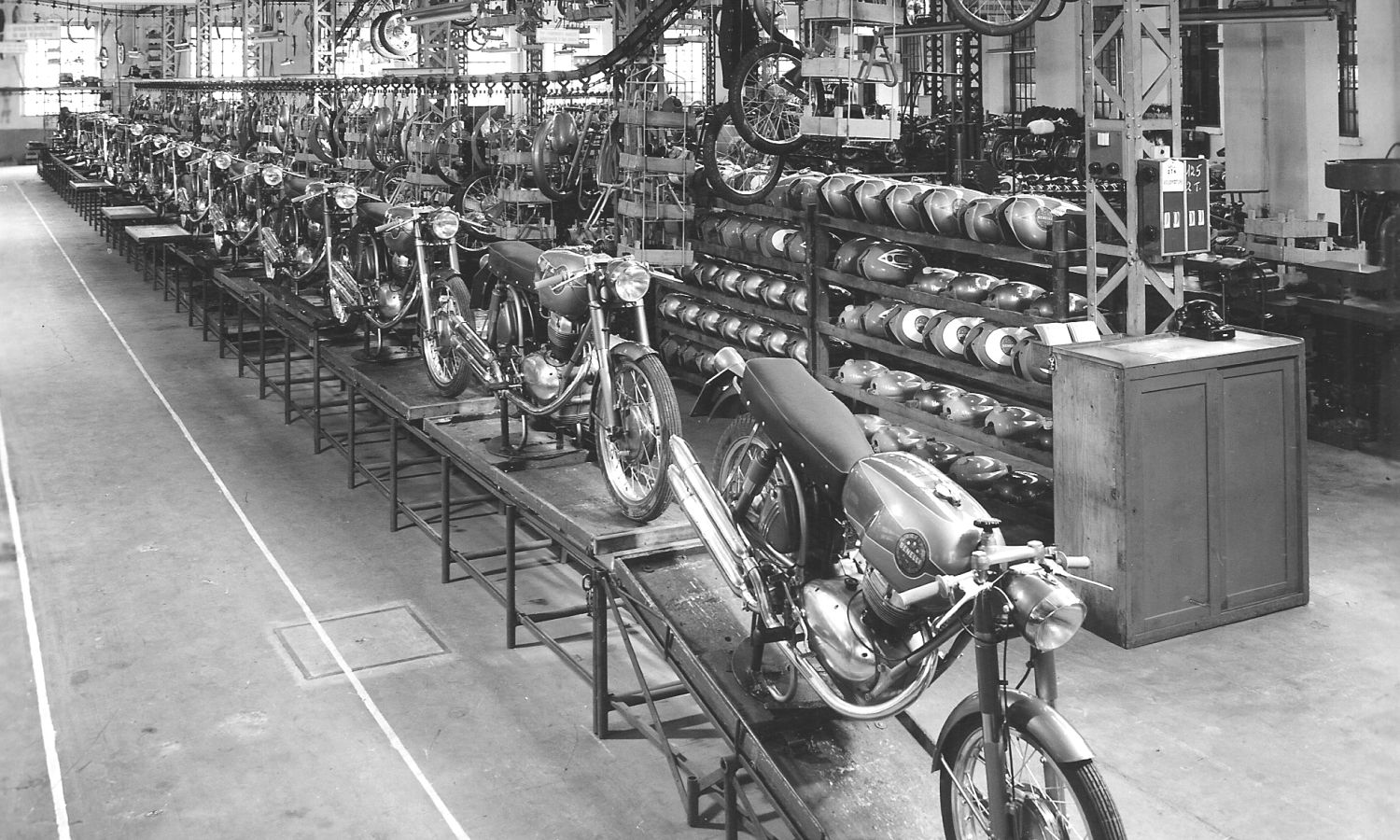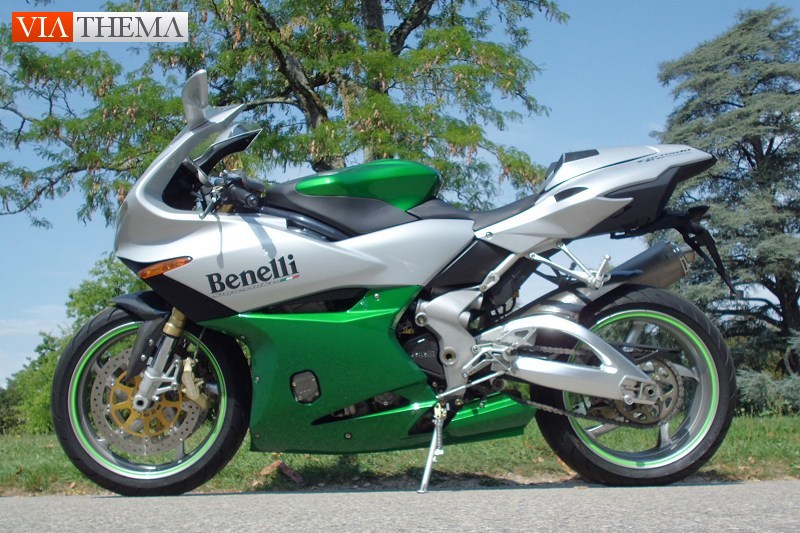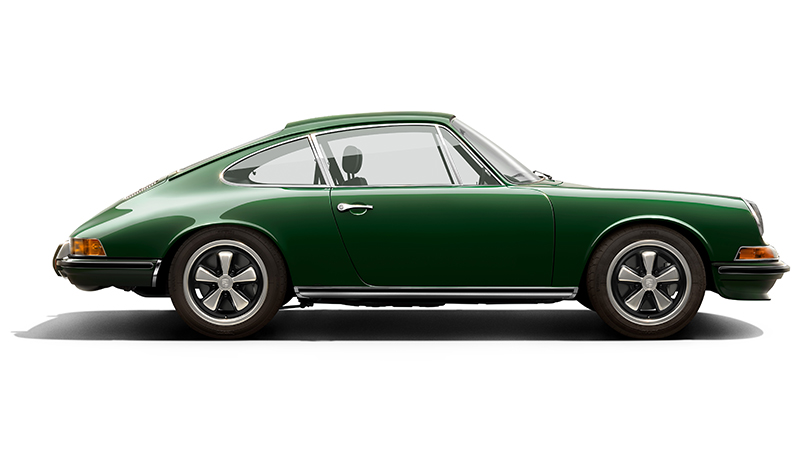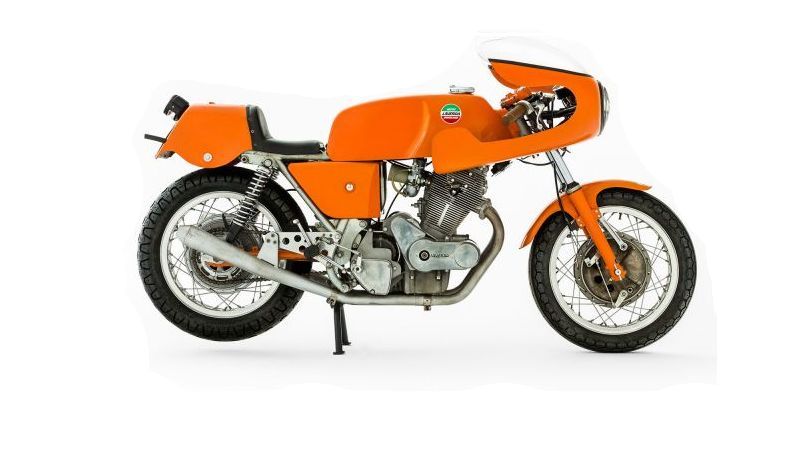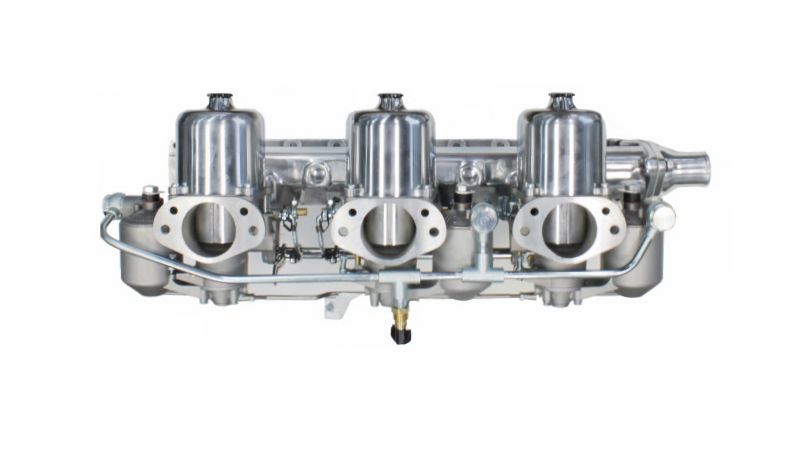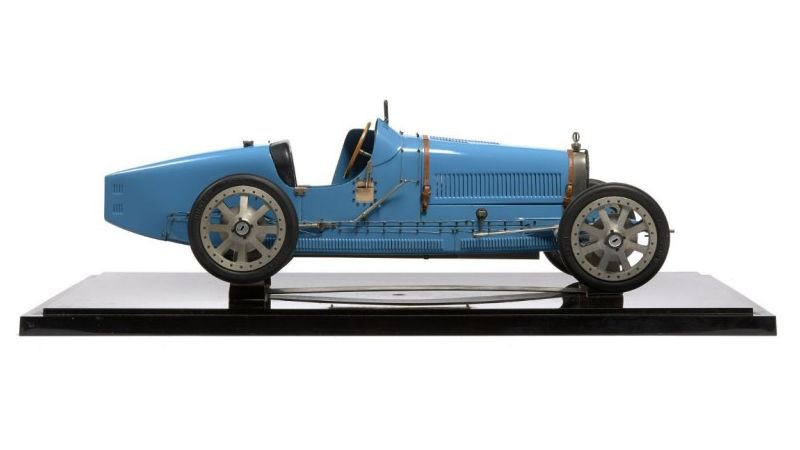Benelli Motorcycles
example Benelli for Sale
Fabbrica Motocicli Fratelli Benelli Pesaro S.p.A.
Fabbrica Motocicli Fratelli Benelli Pesaro S.p.A. has a sterling history of race successes dating back to the 1920s with a family of riders and inventors who catapulted the little factory to the top echelons of racing.
During more than 40 years, the Benelli name has been synonymous with racing and World Championships as well as the special Italian devotion to supercharged multi-cylinder racing exotica immediately prior to WW2.
The factory's story begins with Teresa Benelli, recently widowed in 1911, who sold a bit of family property and invested the proceeds in machine tools, establishing a business at which her 6 sons could make a living.
The Benelli Garage in Pesaro employed 5 of the 6 boys, who repaired guns, cars, and motorcycles. At this early date, factory spare parts for cars and motorcycles could be difficult to obtain, and the workshop was fully equipped to fabricate any part necessary for repairs.
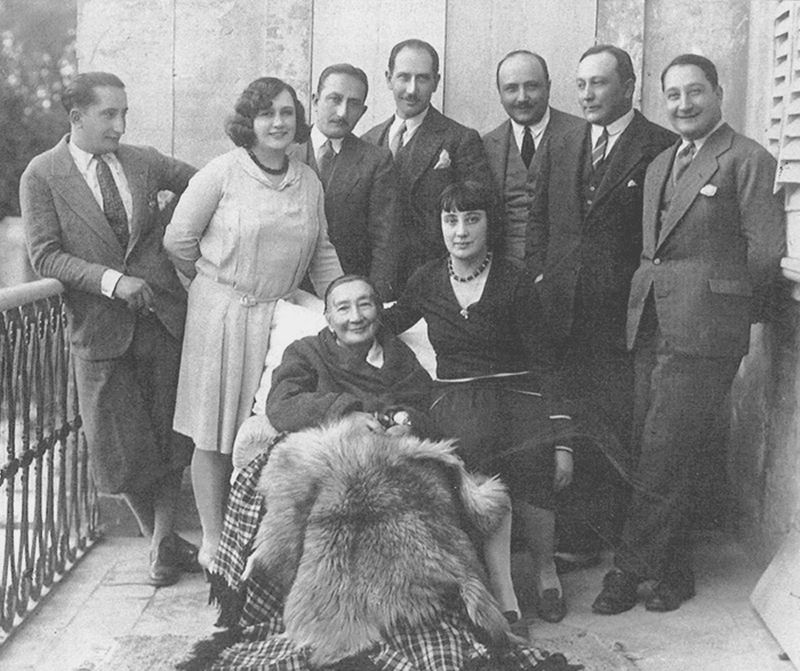
Antonio Tonino, Francesco, Giovanni, Guiseppe, Filippo, Domenico & Teresa Benelli
Antonio 'Tonino' wasn't old enough to work with his brothers', but obsessed with motorcycles which ultimately led him to be a championship rider for the family business. Hence, by 1918, he convinced his brothers' to start making plans to create their own motorcycle.
In 1919 they built a 75cc two-stroke single-cylinder engine and by 1920 they created their first motorcycle, with a larger 98cc engine attached by outrigger tubes to the rear of a bicycle.
The awkward engine position equated to poor handling, and their first machine was a disaster, so by 1921 the engine was moved to the regular position within the frame, and the engine capacity increased gradually to 150cc, featuring a two-speed gearbox as well as chain drive transmission.
Young Tonino always pressured his brothers for more power, with the intention of racing. They obliged, and in his very first race, Tonino placed second, behind Gino Moretti riding a 500cc Moto Guzzi, proving both his skill, and the potential of the little machine.
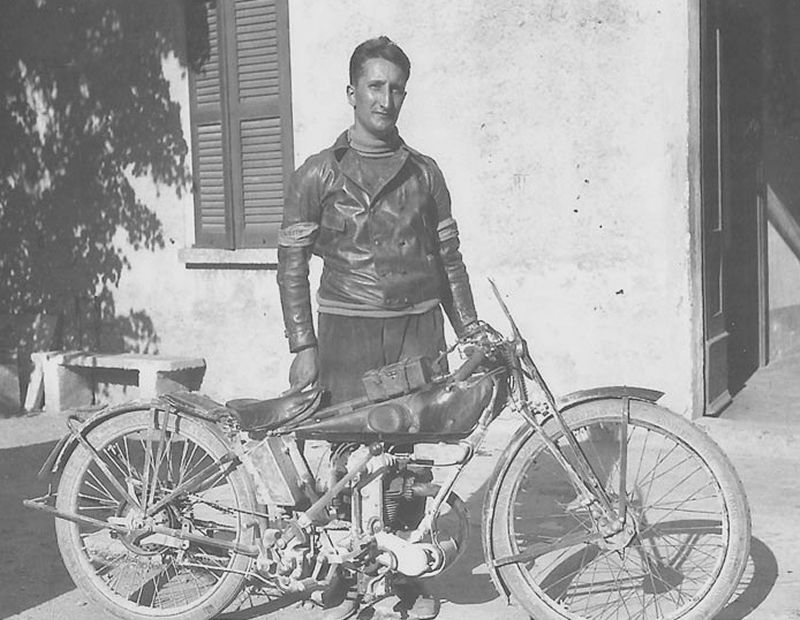
Tonino Benelli with a 175 Monalbero Corsa
The little Benelli failed to win a race in the next two years, but Tonino honed his skills as a rider, while his brothers learned valuable lessons from breakage and failure. Wins began in 1924, and continued, while the Italian public took note of the little machine. The increased sales meant they could buy new machine tools to create a new four stroke motorcycle with advanced specifications.
In 1927, Giuseppi Benelli designed this new 175cc machine with a stack of delicate gears driving an overhead camshaft. It was an impressive lightweight machine, and a natural candidate for the race track.
The overhead camshaft engine proved reliable and fast, and Tonino gathered a string of wins, including Benelli's first international win at the Monza Gran Prix, culminating in the Italian 175cc Championship in both 1927 and 1928.
Now with a proper racing team, Benelli continued to rack up wins in 1929, and Tonino won the Italian Championship again in 1930.
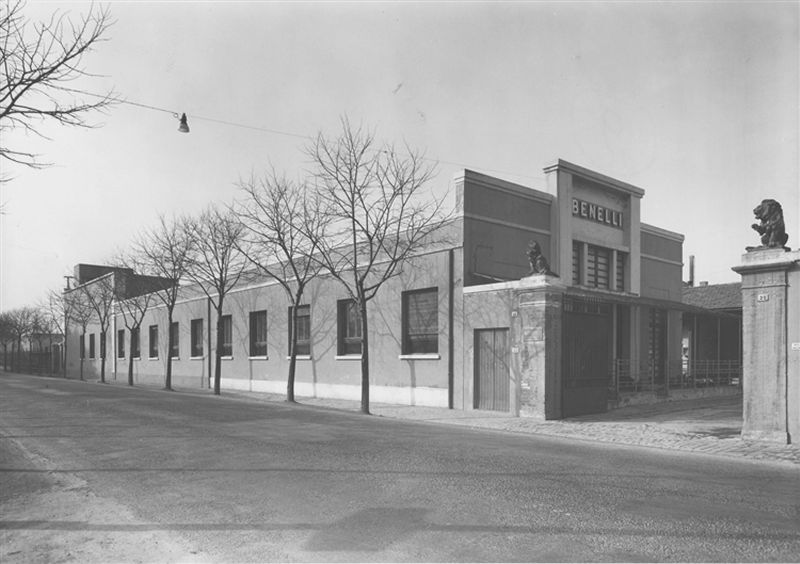
Fabbrica Motocicli Fratelli Benelli Factory Entrance
In the search for more power, another camshaft was added and the new double overhead camshaft 175cc racer debuted in 1931. A very advanced machine and the technical equal of any racer of the day. The engine still had an iron cylinder head and barrel, and initially a hand-shift 3-speed gearbox, but by 1932 a four speed box with footshift brought the little Benelli up to date.
The Benelli race team ventured across Europe in a bid for increased export sales, winning GPs in France, Belgium, Holland, and Switzerland, effectively dominating the 175cc class through 1934 with their cracking little double-knocker lightweight.
But then the FIM abolished the 175cc racing class in 1934, and suddenly Benelli had racers without a category. Rather than immediately enlarge their racer to the 250cc class, they spent the next few years consolidating their roadsters, and capitalizing on their new visibility across Europe.
By 1936 their model range were all single-cylinder, overhead-camshaft machines of 175cc, 250cc, and 500cc. These roadsters were all fast, reliable, and popular, and Benelli became the fifth-largest motorcycle manufacturer in Italy. By 1938, their 250 Sport S roadster was good for 149km/h, a figure not bettered by a production 250 until the 1960s.
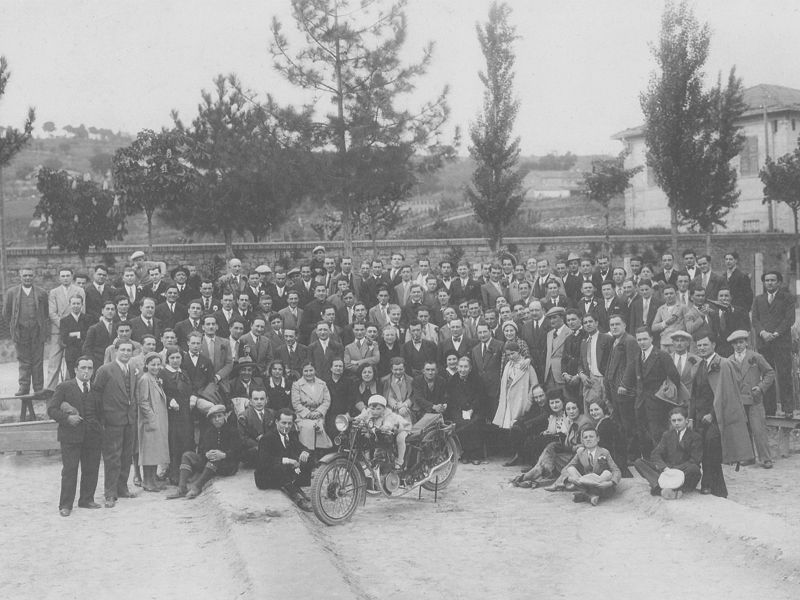
Fabbrica Motocicli Fratelli Benelli Pesaro
However, racing beckoned and Benelli could not rest on its laurels forever. While the production range was consolidated, the race shop designed a completely new all-alloy 250cc Bialbero racer in 1938 featuring a swingarm with plunger springboxes and friction damping rear suspension.
The new engine could be revved to 9000rpm, and proved nearly bomb-proof, even at 176 km/h. Though the competition had changed dramatically as GP racing gained international sporting significance and much larger companies were prepared to invest heavily in new technology and very advanced racing machines.
In the 250cc field, Benelli's most significant competition came from Moto Guzzi, with their supercharged flat single as well as DKW with their supercharged two-stroke. Even with their blowers, these machines had trouble shaking off the solid and good-handling Benelli, which could be every bit as fast as its rivals, and definitely more reliable.
A 1-2-3 at the 1938 Italian GP was an eye-opener for all concerned, especially riders in the 350cc class, whose race averages were slower than the winning 250. Englishman Ted Mellors took note, as his own 350cc Velocette MkVIII KTT had been outclassed by the winning Benelli of Francisci Bruno.
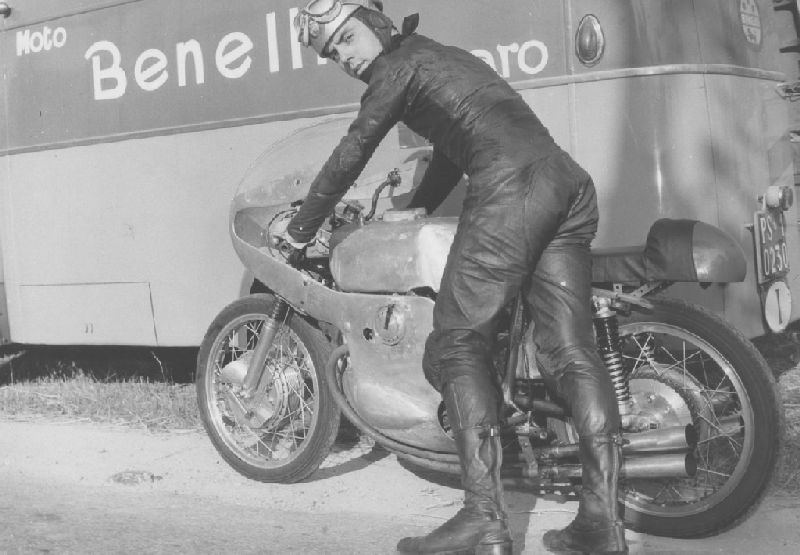
Benelli works rider Silvio Grassetti with a 1969 Benelli 350-4
Mellors approached Benelli about a ride for the 1939 Isle of Man Lightweight TT. An experienced and successful Island rider for the most difficult and prestigious road race in the world was an opportunity the factory desired.
In that tense year of 1939, great forces stood poised on the brink of armed conflict, and every international sporting contest became a proxy war between nations. The Isle of Man TT had been the private playground of English motorcycle companies since the 1-2-3 Indian victory of 1911, with only occasional losses to the 'foreign menace'.
The lineup of racers at the 1939 TT showed a glaring technological gap between Continental and English machines, as well-developed supercharged, multi-cylinder bikes from Europe had become reliable enough to seriously challenge the solid, good-handling English single-cylinders. In the 250cc race, the blown Moto Guzzis and DKWs were fastest, but the Benelli was no slouch, and its reliability proved the decisive asset which assured a win for Ted Mellors.
Benelli, in common with every other racing team, had seen the future in 1938, and begun developing a four-cylinder engine of their own; a 250cc with a supercharger and twin overhead cams. The machine was built in 1939, and proved incredibly fast, pumping out 52.5hp and rocketing to 234 km/h, a mere 26 km/h faster than their nearest rival, the Moto Guzzi.
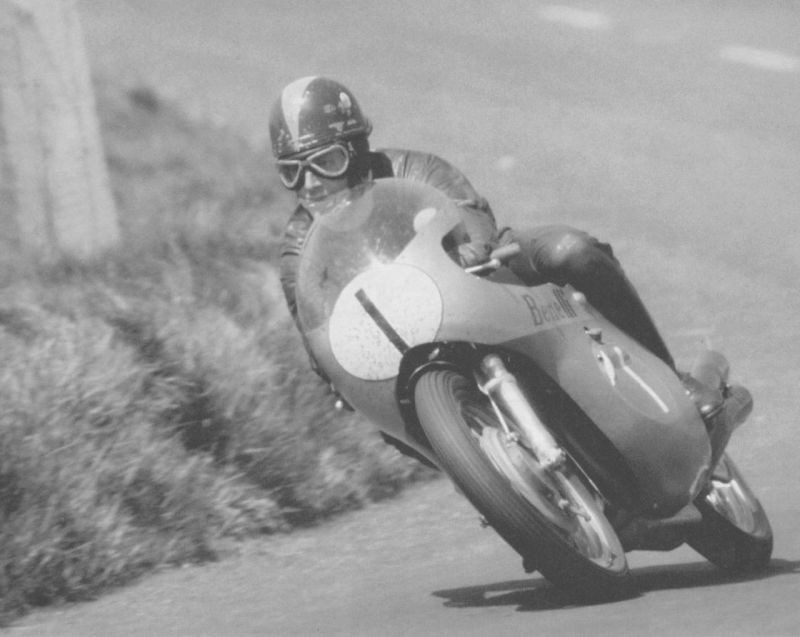
Benelli works rider Kel Carruthers with a 1969 Benelli 250-4
The machine was ready by 1940, but international racing came to a halt due to WW2. The Benelli brothers, fearing the worst, hid their four-cylinder engine in a dry well in the countryside, and scattered their racing singles in barns and cellars across northern Italy.
The factory was completely destroyed in the war, and their machine tools stolen by retreating German forces. When the smoke cleared, it was the sons of fratelli Benelli who had the energy to begin again, even tracking down some of their tooling in Germany and Austria! Their first post-war machines were modified ex-military Harleys, Matchlesses, and BSAs, to which they fit swingarm rear suspension.
At the end of 40's, Giuseppe Benelli left the company due to irreconcilable disagreements with his brothers. It was the beginning of Motobi, with the classic 2 and 4-stroke egg-shaped engine, of small and medium displacement.
Within two years, Benelli were again making their own motorcycles, mostly utilitarian lightweights. And racing! Enough of their prewar racing singles survived to form a Works team, and rider Dario Ambrosini chalked up win after win in 1948 and 1949. The FIM created the first World Championship series in 1949, and Benelli decided to invest in a bid to win for 1950, sending Ambrosini abroad to battle against rival Moto Guzzi, who shared their ambition.
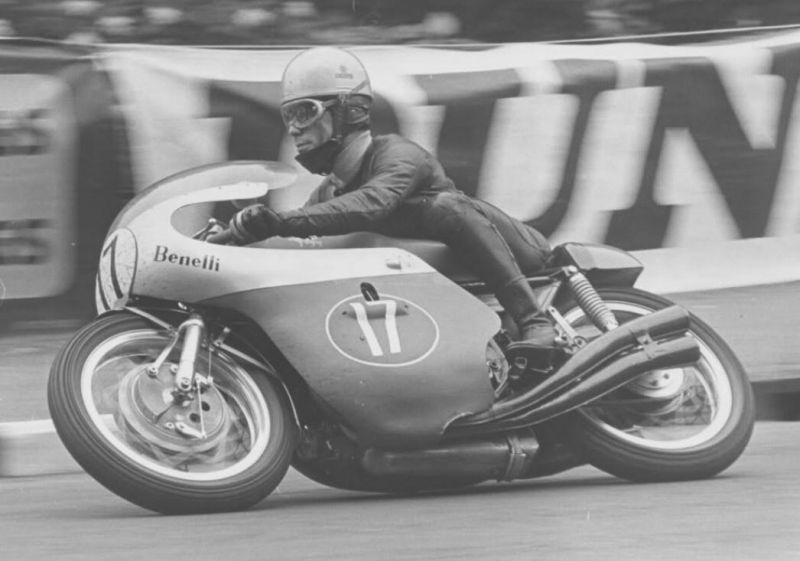
Benelli works rider Renzo Pasolini racing a 1970 Benelli 350-4
Dario Ambrosini had never raced at the Isle of Man TT, but proved a fast learner, shaving 66 seconds from his time between laps 2 and 3, during the race! His win at the 1950 Lightweight, plus Monza and the Swiss GP, gave Benelli their first World Championship. Hopes for a repeat in '51 were dashed when Ambrosini was killed during practice at the Albi GP in France. Stunned by Dario's death, and with no other rider in their team, Benelli withdrew from GP racing for a few years.
The manufacturing activity of Benelli continued in 1951 with the presentation of the Leoncino whose great commercial success was at its peak when Benelli won the first Motogiro d'Italia in 1953 with Tartarini.
They returned to racing in 1959, building just four machines, all short-stroke versions of their 250cc DOHC singles. Benelli's rivals, Ducati and MV Agusta, used high-revving twin-cylinder racers in the 250cc class, and while Geoff Duke won the Swiss GP in '59, this was the only and last victory for these single-cylinder racers.
In 1961 the company of Pesaro celebrated its first 50 years and the following year, to tackle the crisis of the motorcycle industry, the two brands Benelli and Motobi were merged into one. During these years, Benelli also decided to present its first model of bike: it was called Letizia, in honor of the daughter of Giovanni Benelli. This model was an immediate success with over 2,000 units sold in a few months.
As with 1939, it was clear that multi-cylinder racers were necessary to win a GP, and in 1960, Benelli's Ingeniere Aulo Savelli took inspiration from the 1940 four-cylinder racer, and created a new four. It was the start of the heroic times of Provini e Pasolini, of the 4-cylinder 250-350-500 racers and of the second world title in 1969 with the Australian racer Kelvin Carruthers.
In 1969, Benelli introduced the Benelli Tornado 650, a vertical twin designed primarily for sale in Great Britain and the US. The Tornado earned a reputation for reliability and high performance, despite its somewhat hefty weight at 218 kg. Benelli claimed at the time of launch that the Tornado was capable of 57 hp at 7,400rpm and a top speed of 187 km/h. The Tornado and Tornado S were discontinued in 1974.
Benelli together with its competitor Moto Guzzi were acquired by Argentinian industrialist Alejandro de Tomaso in 1973. This lead to the development of new models featuring multi-cylinder engines. The 350 & 500 Quattro Four as well as the incredible 750 Sei powered six-cylinder put the firm briefly ahead of the Japanese competition.
Although technically advanced, Benelli motorcycles of the 1980s were plagued by problems, and production was finally stopped in 1988 when the company was merged into Moto Guzzi to become Guzzi Benelli Moto S.p.A. Production plants in Pesaro were sold.
After a failed attempt to revive the brand backed by Pesaro-based manufacturer Giancarlo Selci in 1989, in 1995 Andrea Merloni bought the rights to the Benelli brand from de Tomaso. Needing a relaunch model, he noted the success of John Bloor in reviving Triumph Motorcycles Ltd, and so briefed a design team to build a stylist and exclusive motorcycle around a distinctive triple-cylinder 900cc capacity engine initially designed as the new Laverda triple.
The three cylinder Tornado Tre 900 super sports bike was presented at the Milan EICMA motorcycle exhibition on 21st July 1999, and the TNT roadster some years later.
We are looking for the following motorcycles. If you do have any of the below listed vehicles - and you are ready to sell - please Contact Us.
| Grand Prix |
|---|
| 248 |
| 250-4 |
| 350-4 |
| Leoncino Corsa |
| 175 |
| Lusso |
| Sport |
| Monza |
| 250 |
| Sport Bialbero |
| Grand Prix |
| 500 |
| Sport Bialbero |
| Grand Prix |
| Sei |
| 750 |
| 900 |
We buy, sell, broker, locate, consign and appraise exceptional classic, sports and collector Benellis'
Contact us when you are serious about buying a fine Benelli Motorcycle or to arrange a free and confidential valuation with a view to selling.
